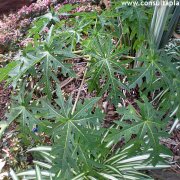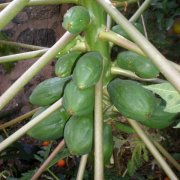Care of the tree Carica papaya or Papaya tree |
|
The genus Carica, family Caricaceae, has gone from having about 20 species of shrubs and trees to a single representative: Carica papaya, native to Central America. Common name: Papaya tree. This species is native to Central America. They are dioecious tropical trees (female plants and male plants) that reach 5 meters (16.4 feet) in height. The stem is hollow, does not usually branch out and reaches 20 cm (7.87") in diameter. They have large, attractive, highly lobed leaves with a long petiole. The whole plant has an irritating latex from which papain is extracted, used to tenderize meats. The flowers are not interesting from an ornamental point of view. The fruits (papayas) are excellent edibles. In addition to the commercial use of its fruits, this tree can be a very ornamental plant in gardens where the climate allows it, as isolated specimens or in small groups. Carica papaya can grow in direct sun and semi-shade exposures; It is a tropical plant that needs high humidity and does not resist cold. The soil should contain enough organic matter (humus), be well drained and be light. Water abundantly so that the soil is always moist but never flooded. It does not resist drought. Fertilize with manure before planting and then every year in autumn. Papaya tree does not need pruning. Carica papaya can be attacked by mites and aphids if the humidity is low. Papaya tree propagates by cuttings or by seeds previously soaked for several days. |
Images of the tree Carica papaya or Papaya tree |
Find plants
Carica papaya or Papaya tree | Care and Growing
© 2025 FavThemes




